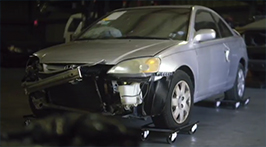Toasters are used to brown bread products such as sliced bread, bagels and English muffins within a compact countertop unit. Increasingly inexpensive and simple to use, most American homes have at least one toaster while many households have both conventional pop-up style toasters and toaster ovens.
Toaster ovens present a wide array of cooking capabilities and provide convenience not necessarily offered by traditional cooking devices. Toaster ovens are small electric appliances with a hinged, fold-down front door and heating rack within a primary chamber. They can perform many of the heating functions of larger, household ovens, and are operated in a very similar fashion.
Toaster Defects
Toasters are documented to have the following vulnerabilities:
• Sharp metal edges leading to potential for lacerations of skin
• Exposed electric heating elements and powered components with potential for electric shock
• Heating elements and hot parts that may potentially lead to burns or scalds
• Electrical power cords and components leading to electric shock
• Fire-causing components, cords, heating elements
• Smoke inhalation risk due to burning food or fire
• Power cords enabling young children to pull the unit off a counter resulting in bodily injury
• Other defective factors
General Product Failure
Toasters heat quickly and with great power. Due to their utilization of electricity, exposed heating elements and hot surfaces, toasters enable a multitude of hazards even when properly used by consumers. On top of these general risks, many toaster recalls occur each year when defects are discovered by consumers or manufacturers that violate the safety standards established by the Consumer Product Safety Commission. Some examples of such recalls resulting from general product failure include:
• In 2009, 1500 toasters were recalled when the manufacturer noted a defective mechanism continued to provide heating power to the toaster elements even after toasting was completed, the bread position was “up” due to that completion and food was removed.
• In 2002, 95,000 toasters were recalled due to continued heating after normal use was completed, also due to defective manufacturing. Three home fires resulted from this defect.
• Without reports of injuries or fires, 2700 electronic toasters were recalled in 1994 due to defective electrical components causing self-starting of the units.
• In 2008, Walmart recalled 210,000 General Electric toasters after 140 consumers reported fire and sparks generating from their appliances. Most homes only suffered tripped electric circuit breakers and did not sustain significant damage.
Statistics
Of 30 documented emergency room visits sampled and reported by the National Electronic Injury Surveillance System in 2008, the following injuries were reportedly caused during the operation or use of a toaster:
• eight injuries included lacerations from defective, jagged or protruding parts
• one laceration injury was the result of the toaster being pulled off a counter by a young child
• six injuries included smoke inhalation after fire ignited as a result of toaster or toaster oven operation
• one injury involved serious contusions from dropping of the unit on a hand
• one injury was the result of electric shock experienced during the plug-in of the power cord
• one burn injury resulted from sparks emitted from the power cord
• 12 injuries were due to burns and scalds
In 1998, toasters caused 2200 home fires, 20 deaths and 90 injuries. Over $13.3 million in residential property damage also occurred as a direct result of home fires started by toasters. In 1990, 2700 toaster-generated home fires occurred, resulting in 10 deaths and 80 injuries.
Toaster Recalls
In cooperation with the Consumer Product Safety Commission, defective toasters may be recalled by their manufacturers for repair of malfunctioning parts or defects. Some past examples include:
• In 1997, Black and Decker exercised a recall of 234,000 Spacemaker Optima Toasters, which resulted in 1,066 home fires when some of the toasters continued to produce heat beyond the normal heating cycle. The malfunction resulted in damage to 656 homes and eight injuries. The Consumer Product Safety Commission intervened in 1998, claiming Black and Decker was not doing enough to ensure consumer protection. They maintained the company negligently publicized the defect, causing only 19,000 customers to return potentially defective toasters. Over 200,000 of the toasters were suspected to remain in use despite the high risk of fire and injury associated with them.
• In 2009, five consumers were electrically shocked by Viking Range Corp’s toasters, which cost $300 per unit, due to loose internal wiring within the appliances. Ten thousand units were recalled.
• In 2009, Haier America Trading recalled 106,000 toaster ovens after loose electrical connections within the unit’s body resulted in two minor burns and one electrical shock in three separate consumers. One home suffered property damage.
